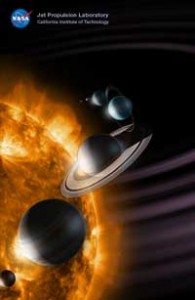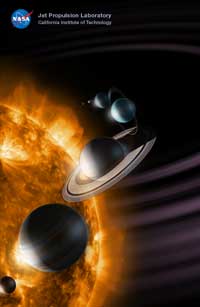 THUNDER BAY – International News – From Europe comes an innovative program. In both the United States, where NASA is engaging youth to connect via social media with astronauts aboard the International Space Station, and in Europe with the 7th Annual Researcher’s Night, the goal is bringing science into the hands of youth.
THUNDER BAY – International News – From Europe comes an innovative program. In both the United States, where NASA is engaging youth to connect via social media with astronauts aboard the International Space Station, and in Europe with the 7th Annual Researcher’s Night, the goal is bringing science into the hands of youth.
You can wait 75 years for a glimpse of Halley’s comet; but did you know you can make one yourself in just a few minutes? All it takes is a mixture of day-old dry ice, water, mud and a few other components – and you have a comet of your very own.
How cosmic is that? Learning how to make a comet with space scientists in London, creating a cloud with meteorologists in Bolzano, Italy. and exploring the San Antonio volcano with geologists in the Canary Islands are just a few of the highlights of the 7th Researchers’ Night, taking place at a host of venues throughout Europe tomorrow evening (28 September).
Around 350 cities, from Akureyri (Iceland) to Nicosia (Cyprus), will take part in the event, with the aim of discovering science in a fun way and raising interest in research careers. The public will be able to take part in experiments, join interactive science shows, visit usually restricted research laboratories and try out complex equipment.
“This is an opportunity for anybody to become a scientist for a night,” said Androulla Vassiliou, European Commissioner for Education, Culture, Multilingualism and Youth. “As well as being educational and fun, the annual Researchers’ Night is a great way of getting girls and boys interested in pursuing research as a career.
“A youngster who learns how to make invisible ink in the classroom today may well become a scientist addressing Europe’s most acute societal and economic challenges tomorrow,” added the Commissioner.
During Researchers’ Night, scientists from all disciplines take over public spaces – shopping malls, squares, historic monuments, parks, and museums – to show people of all ages how their work impacts on daily life.
Hundreds of events will take place in 32 EU and neighbouring countries (see list below). Take a look at the city highlights in the appendix or find an event close to you.
Background
What is Researchers’ Night?
Researchers’ Night takes place every year across Europe on the fourth Friday of September. There are events taking place in 24 EU Member States, as well as Bosnia and Herzegovina, the Faroe Islands, the former Yugoslav Republic of Macedonia, Iceland, Israel, Montenegro, Serbia and Turkey. The three Member States which are not taking part this year are Austria, Denmark and Luxembourg.
The event has grown from 92 participating cities in 2006 to over 350 cities this year. Nearly 800 000 visitors attended it in 2011, and the number is expected to increase this year.
Why is the EU investing in the event?
Researchers’ Night is part of the EU-funded Marie Curie Actions, which promote international research careers in Europe. By bringing researchers directly into contact with the public, the event aims to show the important role research plays in society. Encouraging more people to choose a career in research is crucial for Europe’s future growth, which is increasingly dependent on innovation in products, services and business models.
The EU funds slightly more than half of the overall cost of Researchers’ Night’s: € 4 million out of nearly € 7.5 million this year. Event activities and organisers have been selected through a competitive process following a call for proposals.
In total, the Marie Curie Actions are supported by €4.7 billion in EU funds. They are almost entirely managed by the European Commission’s Research Executive Agency, as part of the 7th Framework Programme for Research and Technological Development (FP7), the EU’s main research funding package for 2007-2013 worth €50 billion.
Marie Curie Actions are a part of Horizon 2020, the EU’s proposed new programme for research and innovation. Horizon 2020 will run from 2014 to 2020 and with an €80 billion proposed budget it is part of the drive to create new growth and jobs in Europe.
City highlights
London (United Kingdom): The Natural History Museum will host a comet-building workshop. The formula at the origin of comets orbiting in the solar system will be applied to components found on Earth, such as water and mud. The public will also have the chance to get their hands dirty using charcoal to recreate cave art with anthropologists. A giant sculpture made of thousands of baby teeth donated by the public will be erected on the Whitechapel campus of the University of London (Queen Mary).
Bolzano (Italy): Thrill-seekers will be able to test survival methods in the extreme conditions of a cold chamber and in a simulated snow storm at the European Academy of Bolzano. They will get feedback on their body’s reaction after the test. Weather enthusiasts will have the opportunity to create clouds using water, air and pressure at the meteorological office.
Fuencaliente (Canary Islands, Spain): Together with scientists and professional guides, adventurers will get the chance to explore the San Antonio volcano, which hosts unique flora, rock formations and coloured lava structures. Local producers and geologists will show how the volcano improves the quality of regional wines.
Krakow (Poland): Science shows at 17 venues will include a demonstration on how motion-capture technology used for video games can help diagnose and treat diseases. The Institute of Nuclear Physics will show particle accelerators used for eye cancer treatments or to detect the composition of unknown substances, which can help discoveries in art conservation, medicine and geology.
Angers, Besançon, Toulouse (France): Fans of time travel in French cities will create a future society based on research and innovation. The public and scientists will imagine Angers in 2025, Besançon in 2084 and Toulouse in the second half of the century, based on potential developments in education, transport, environment, energy and other aspects of society.
Nicosia (Cyprus): The game “Tell me, Dr Turing, can machines think?” will challenge participants to distinguish the human voice from computer sounds in a conversation. It is based on a test formulated in the 1950s to assess a computer’s ability to show intelligent behaviour and respond in the same way a person might.

